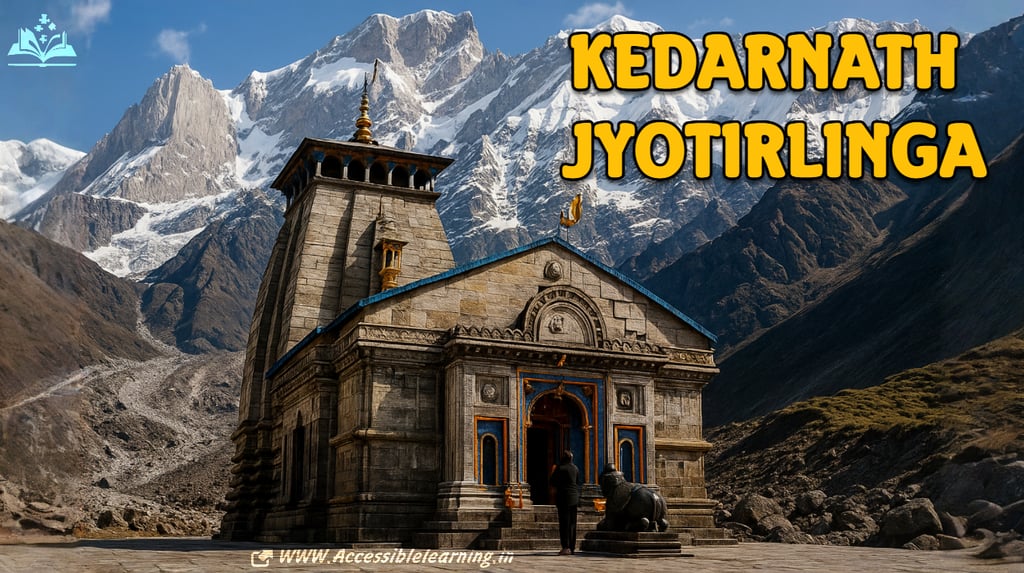
Kedarnath Jyotirlinga: A Divine Journey to the Himalayan Abode!
Located in the Garhwal Himalayan ranges of Uttarakhand, India, Kedarnath Jyotirlinga is one of the twelve Jyotirlingas, the most sacred abode of Shiv Ji. Situated at an altitude of 3,583 m near the Mandakini River.
TRAVEL LIFESTORY/ENTERTAINMENTINDIA/BHARAT
Sachin K Chaurasiya
7/21/20255 min read


Located in the Garhwal Himalayan ranges of Uttarakhand, India, Kedarnath Jyotirlinga is one of the twelve Jyotirlingas, the most sacred abode of Shiv Ji. Situated at an altitude of 3,583 m near the Mandakini River, the temple is not only an important pilgrimage site but also a marvel of natural beauty surrounded by majestic snow-capped peaks.
Historical & Mythological Significance
Origin & Construction
The Kedarnath Temple (केदारनाथ मंदिर) is believed to have been originally constructed by the Pandavas (पाण्डव) from the Mahabharata. According to legend, after the Kurukshetra War, the Pandavas sought the blessings of Shiv Ji to atone for their sins. However, Shiv Ji, eluding them, took refuge in Kedarnath in the form of a bull. When the Pandavas tried to catch him, Shiv Ji dove into the ground, leaving his hump on the surface. The present-day Kedarnath Temple is said to be built around this hump. The temple was later reconstructed by Adi Shankaracharya (आदि शङ्कराचार्य) in the 8th century, adding to its spiritual and historical significance.
Mythological Tales
The story of Kedarnath is deeply intertwined with the epic tales of the Mahabharata. The Pandavas, remorseful for the deaths caused during the war (Mahabharata/महाभारत), sought Shiv Ji's forgiveness. Initially unwilling to absolve them, Shiv Ji transformed into a bull (बैल) to hide. When the Pandavas found him, Shiv Ji dove into the earth, leaving his hump on the surface. This hump became the site of the Kedarnath Temple. Other parts of Shiv Ji's body are believed to have emerged at different places, forming other Panch Kedar temples.
Adi Shankaracharya's (आदि शङ्कराचार्य) Contribution
Adi Shankaracharya, the great 8th-century philosopher and theologian, is credited with constructing the present structure of the temple. He established four Mathas (मठ) (monastic centers/मठवासी केंद्र) across India, with Kedarnath being one of the prominent temples in the northern Matha. Adi Shankaracharya is also believed to have attained Mahasamadhi (महासमाधि) (final liberation) at Kedarnath, and his samadhi (memorial) is located behind the temple.
Architectural Grandeur
The Kedarnath Temple is built from large, evenly cut grey slabs of stone, standing on a rectangular platform. The temple features a Garbhagriha (गर्भगृह) (sanctum sanctorum) where the primary deity resides. The structure is adorned with intricate carvings and sculptures of various deities and mythological scenes. The conical lingam, representing the hump of Shiv Ji, is the main focus of worship.

Pilgrimage & Rituals (तीर्थयात्रा और अनुष्ठान)
Char Dham Yatra (चार धाम यात्रा)
Kedarnath is one of the Char Dhams, the four most revered pilgrimage sites in Hinduism, which also include Badrinath, Yamunotri, and Gangotri. Devotees undertake the arduous journey to Kedarnath as part of this sacred pilgrimage circuit.
Seasonal Worship (मौसमी पूजा)
The temple is open to pilgrims only for six months in a year, from April (Akshaya Tritiya/अक्षय तृतीया) to November (Kartik Purnima/कार्तिक पूर्णिमा). During winters, the deity is taken to Ukhimath, where he is worshipped for the remaining six months. This seasonal migration ensures that the temple does not suffer any damage during the harsh winter season.
Natural & Geographical Significance
The Kedarnath Temple is nestled in the breathtaking Kedarnath Valley, surrounded by towering peaks such as Kedarnath, Kedar Dome, and other Himalayan ranges. The region is also home to the Mandakini River, which flows near the temple. The serene and awe-inspiring natural surroundings add to the spiritual ambiance of Kedarnath.
Challenges & Preservation
The Kedarnath region has faced several natural disasters, the most significant being the devastating floods in June 2013, which caused extensive damage to the temple and surrounding areas. Despite these challenges, the temple has been resiliently restored and continues to be a beacon of faith for millions of devotees.


Additional Insights
Kedarnath’s spiritual significance extends beyond its physical presence. The journey to Kedarnath is considered an act of devotion and penance, with pilgrims often braving challenging weather and rugged terrain to reach the temple. The temple's remote location adds to its mystique (रहस्यपूर्ण), making the pilgrimage a transformative experience for many.
The area around Kedarnath is also rich in biodiversity. The Kedarnath Wildlife Sanctuary, established in 1972, is home to a variety of flora and fauna, including the Himalayan musk deer, snow leopard, and numerous bird species. This sanctuary adds another layer of natural beauty and ecological importance to the region.
The Legend of Kedarnath
According to one of the legends, Nara and Narayana (नर और नारायण), the two incarnations of Vishnu Ji (विष्णु जी), performed severe penance in front of a Shivalingam (शिवलिंग) fashioned out of earth. Pleased with their devotion, Shiv Ji appeared in front of them and granted them a boon. They requested Shiv Ji to reside permanently in Kedarnath in the form of a Jyotirlinga so that devotees seeking God's blessings would be freed from their miseries.
Another interesting story associated with Kedarnath is that of Bhima (भीम), one of the Pandavas. It is said that when Shiv Ji, disguised as a bull, tried to elude the Pandavas, Bhima stood with his legs stretched across the mountains, forcing Shiv Ji to appear before them. The place where this happened is believed to be where the Kedarnath Temple stands today.


The Mystical Path to Kedarnath
The journey to Kedarnath is as mystical as the temple itself. The trek starts from Gaurikund (गौरीकुंड), a place named after Goddess Parvati (माँ पार्वती), also known as Gauri. It is believed that Goddess Parvati meditated here to win Shiv Ji's heart. The path to Kedarnath from Gaurikund is steep and challenging, but it is lined with scenic views of lush green valleys, sparkling streams, and the occasional sight of exotic wildlife.
During the pilgrimage season, thousands of devotees from around the world flock to Kedarnath. The atmosphere is charged with chants of "🙏हर हर महादेव🙏" and "🙏जय भोलेनाथ,🙏" creating an ambiance of profound spirituality and devotion.


Travel Guidelines for Kedarnath Pilgrims
Best Time to Visit
Season: April to November (closed during the winter due to snowfall).
Peak months: May to June and September to October.
Getting There
Trek: 16 km from Gaurikund, moderate to difficult. It takes 6-7 hours.
Alternatives: Pony, doli services, or helicopter rides from Phata, Guptkashi, and Sersi.
Accommodation
Options: basic guesthouses, dharamshalas, and tents near the temple. Book in advance.
Nearby towns: Gaurikund, Guptkashi, and Sonprayag.
Health Tips
Altitude Sickness: Acclimatize yourself to Gaurikund; carry essential medicines.
Weather: Be prepared for cold and rain. Carry warm, waterproof clothing.
Environmental Responsibility
Waste: Use designated disposal areas; minimize the use of plastic.
Respect Nature: Follow guidelines to preserve the environment.
Spiritual Preparation
Mental Readiness: Undertake the journey with devotion and patience.
Kedarnath Jyotirlinga is a profound symbol of devotion and spirituality in Hinduism. Its rich history, mythological significance, architectural grandeur, and the arduous journey undertaken by pilgrims make it one of the most revered and cherished pilgrimage sites in India. The temple's connection to the epic tales of the Mahabharata, its construction by Adi Shankaracharya, and its breathtaking natural setting make it a unique and powerful spiritual destination. Despite the challenges posed by natural disasters, Kedarnath remains a resilient and enduring symbol of faith, drawing millions of devotees each year to its sacred grounds.
Subscribe To Our Newsletter
All © Copyright reserved by Accessible-Learning Hub
| Terms & Conditions
Knowledge is power. Learn with Us. 📚


